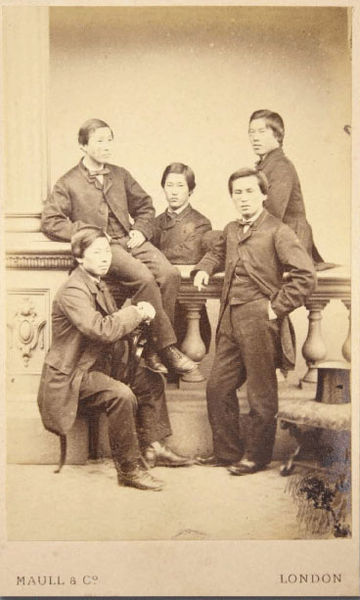Choshu Five event at UCL
 On
3 July, University College London event celebrated the five pioneering
international students who risked their lives traveling to the UK, and who went on to become the architects of modern Japan. On
3 July, University College London event celebrated the five pioneering
international students who risked their lives traveling to the UK, and who went on to become the architects of modern Japan.
The
anniversary of their arrival was marked by a ceremony
supported by the Jardine Matheson Group – the current chairman of
Jardine Matheson Holdings, Sir Henry Keswick, is a direct descendent of
William Keswick, a major figure in the company’s history. There
were speeches by Malcolm Grant provost of UCL, Keiichi Hayashi, the
Japanese
ambassador, former UK ambassador to Japan Sir David Warren, and
representatives of the company. Descendants of the Chōshū Five also
attended, too, as well as Mayor Kouji Nomura of Hagi City in Yamaguchi
Prefecture, the modern name for the former Choshu Clan Domain. There
was also an exhibition of Japanese prints from UCL’s special
collections.
The
most eminent of the group was Hirobumi Itō
(1841-1909), who rose to become four-time prime minister of Japan, the
principle writer of its 1889 Meiji Constitution, as well as a key
player in the establishing of the
University of Tokyo.
In the early 1860s,
explained Shin-Ichi Ohnuma, professor of experimental ophthalmology at
UCL to Times Higher Education in an interview with the newspaper, “Japan faced serious problems,
including a severe economic crisis, difficult relations with foreign
countries such as the US and the UK, and political instability. But
there were those within the two powerful clans of Chōshū and Satsuma
who believed that Japan could learn from the West in many areas.”
The
Chōshū Five secretly made contact with William Keswick, a
representative of Jardine, Matheson & Co – the first foreign
trading house to establish a base in Japan – to secure passage on one
of its ships. Due to sakoku (literally “chained country”), the state
policy banning overseas travel, this was illegal and put the men and
families as well as the men themselves in great danger.
After an arduous 135-day journey, they eventually reached London looking “like hungry crows”.
Hugh
Matheson, the head of Jardine, Matheson & Co, contacted UCL, and
the Chōshū Five were enrolled at the university and taken under the
wing of Alexander Williamson, a chemistry professor who acted as their
teacher, adviser and landlord. They also used their time in England to
visit military facilities and factories, as well as the Houses of
Parliament, the Bank of England, the Royal Mint and the British Museum.
They were fascinated by London’s underground railway and focused their
educational efforts on chemistry, engineering, mathematics, mineralogy
and physics.
According to Prof Ohnuma their experiences
were “a turning point in Japanese history…And after returning to Japan,
the Chōshū Five did indeed apply what they had learned in London to
help transform their country, making them pioneers of modern Japan,
both as a group and individually.”
Besides Itō, Masaru Inoue
became the founding president of the Japanese Board of Railways;
Kinsuke Endo founded the Japanese Mint; Kaoru Inoue became Japan’s
first foreign secretary; and Yozo Yamao, the “father of Japanese
engineering”, established the country’s first institute of technology.
All
were at the heart of a new government responsible for transforming
Japan from an isolated, inward-looking state into a global
technological power.
Footage from the event can be seen here on the UCL news page for the event
|



